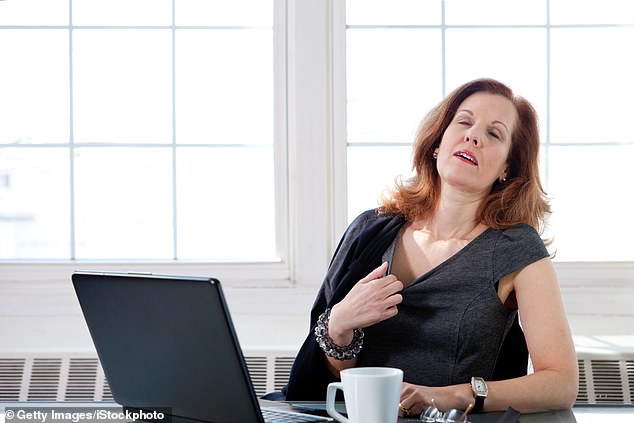Menopausal women struggling with night sweats have been handed some tough-love advice: stop sitting around.
Sedentary lifestyles may be putting them at greater risk of hot flushes during the night, researchers say.
Many women going through the menopause wake up to find their sheets soaking from night sweats – a distressing symptom that can disrupt sleep and cause brain fog during the day.
The US researchers measured night sweats in 77 women while looking at their daytime physical activity using wrist-worn exercise trackers.

Menopausal women struggling with night sweats have been handed some tough-love advice: stop sitting around. Sedentary lifestyles may be putting them at greater risk of hot flushes during the night, researchers say
For every three hours and 20 minutes spent being sedentary, such as sitting or lying down, they had one extra episode of night sweats on average.
Dr Sarah Witkowski, who led the study from Smith College in Massachusetts, said: ‘As researchers, we want to reduce the difficulties many women have through mid-life, and try to make it a little better.
‘It is very easy to sit for three hours at a time, particularly when working or watching television, but these results suggest women might want to take breaks where they get up and move around.’
However, she said more research would need to be done to prove the link.
WHAT IS THE MENOPAUSE?
Menopause is defined as the changes a woman goes through just before and after she stops her periods and is no longer able to get pregnant naturally.
Some women go through this time with few, if any, symptoms, around 60 percent experience symptoms resulting in behavioral changes and one in four will suffer severely.
Common symptoms include hot flushes, night sweats, vaginal dryness leading to discomfort during sex, disrupted sleep, decreased sex drive, problems with memory and concentration and mood swings.
Menopause happens when your ovaries stop producing as much of the hormone oestrogen and no longer release an egg each month.
In the UK, the average age for a woman to reach the menopause is 51, according to the NHS.
Advertisement
The study, being presented today to the annual meeting of the North American Menopause Society, measured women’s night sweats using two electrodes on their chest.
The women, who were mostly post-menopausal or in the early stages of the menopause, had up to nine episodes of night sweats in a night.
But the number was higher on average if they were more sedentary.
It is unclear why exercise and night sweats may be linked, but the menopause alters hormones, which might change the brain’s regulation of body temperature.
And when women’s bodies heat up, their blood vessels, particularly those close to the surface of the skin, expand so heat can escape.
But if women are more sedentary, their blood vessels may be in poorer condition, meaning they don’t expand as well.
That could lead to more night sweats as a result of retaining too much heat.
It might also explain why women with worse hot flushes and night sweats have been found to be at greater risk of heart problems and strokes.
The latest study, which looked at women aged 45 to 55, the usual age for menopause, found no link between sedentary behaviour and daytime hot flushes.
About one in 100 women experience the menopause before they reach 40.
Source link : https://www.dailymail.co.uk/health/article-10016085/Menopausal-women-suffer-hot-flushes-lead-lazy-lifestyles-study-claims.html











